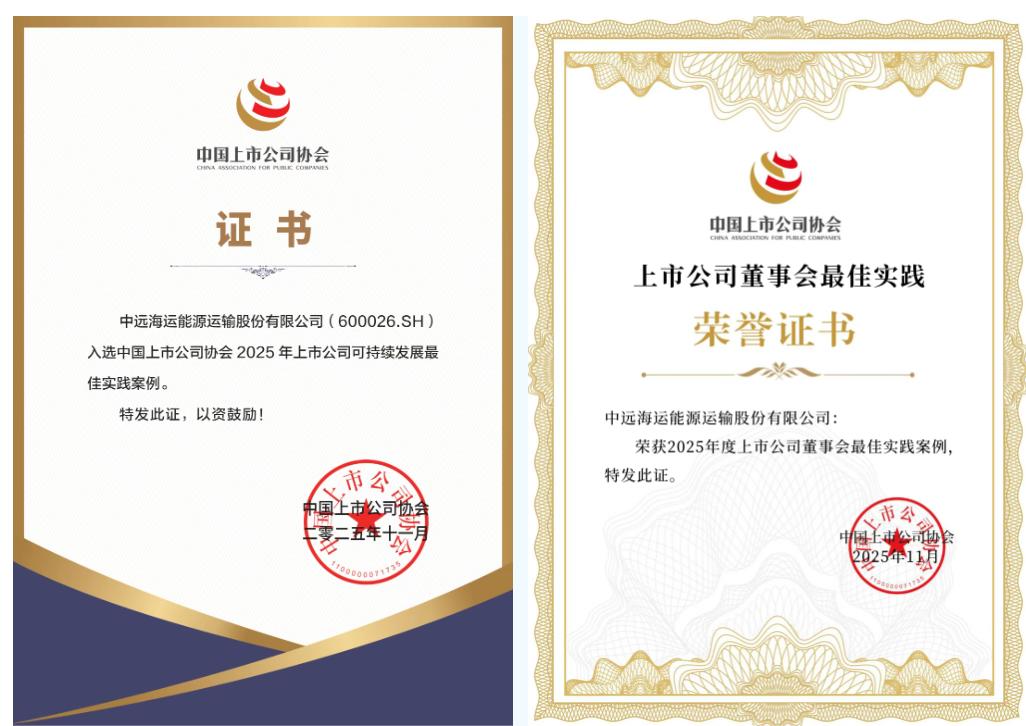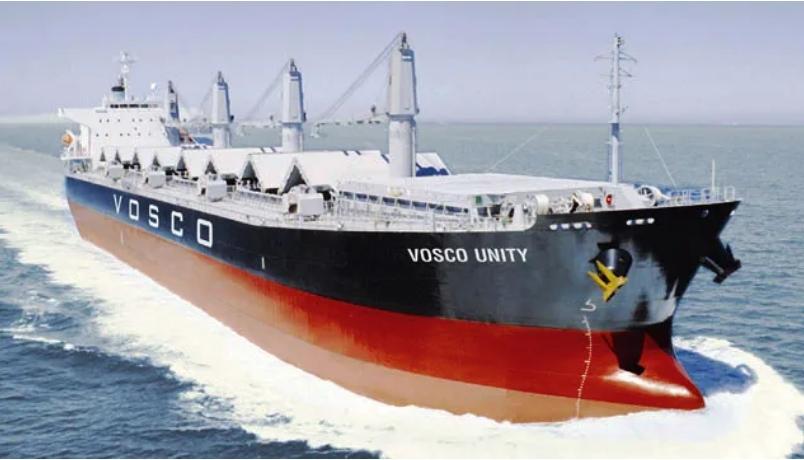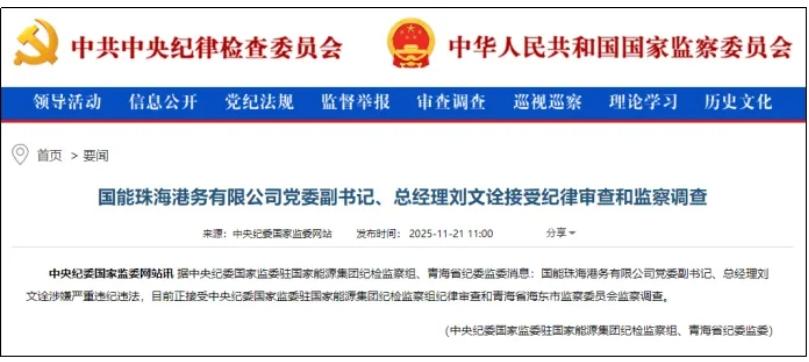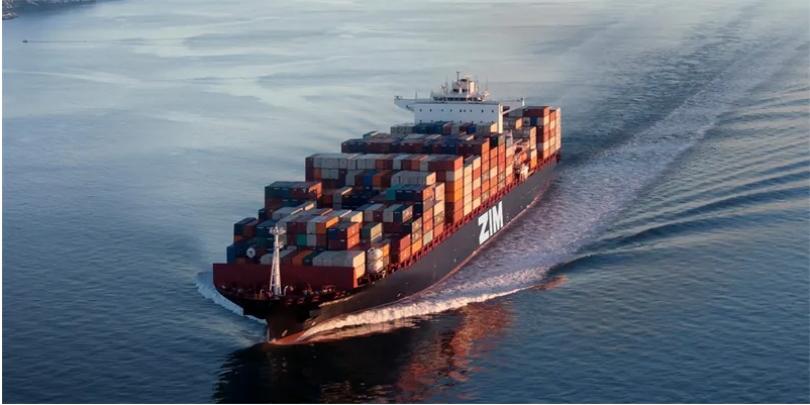问这问题的,一开始咨询的是律师,后来顺便咨询了笔者。其实这可以理解,不少人都这样,看对方的头衔来判断一个人水平的高低。对于这个问题,当时群里似乎没有很好的解决办法,靠打嘴巴说很难有好的效果,但是如果搬出证据来,那么结果可能不一样。如果在处理实务过程中,引援笔者说过的话,那一点效果都没有。但是如果引援笔者所提到过的判例,法官的话去压对方,那么效果将完全不一样。
当时,针对这个问题,笔者答复如下:在这种情况下租家得去举证,他们确实能安排4条作业线同时作业。然后造成了时间上的损失,不然他们无权按比例扣除计算。

当然得看合同条款是如何定的,假如什么都没说,那么应该适用衡平法来考虑,租家得去证明确实有时间损失。如果合同中已经明确规定,坏了就按比例扣除,那么只能认了,按比例扣除。
从另外一个角度考虑,违约的损害赔偿。通常合同会要求船舶得适航适货,机器设备处于可用状态。那么船吊坏了,船东违约,租家可索赔损害赔偿。而想索赔,那么租家得去举证有损失,举证不了,就无法索赔,所以一切都看合同如何规定的。
当时群里并没有人问这个4.86的出处是哪,似乎也不大关心,反正发生了这种事情,租家扣了,船东也拿租家没有办法。但在笔者看来,并非如此,因为这是原则问题,如果举证不了,那么就是不能扣。发生其它事情也一样,必须得尽力去试一试,不试就必然没有结果。假如发生损坏,不去和租家沟通,找权威去说服租家,那么租家理所当然就扣。
第二天早上,怕有人不明白4.86的出处到底是哪,又截图如下,截图部分是魏船长等人翻译的《Laytime and Demurrage》一书,非常好的参考书。在该段中指出,在London Arbitration6/08案中,对于由此造成的时间损失上,仲裁员裁定承租人必须举证有时间损失。
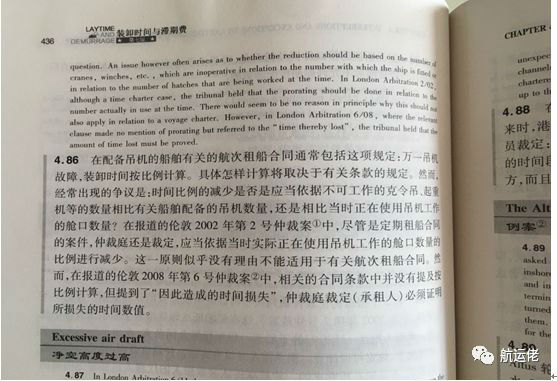
程租的情况如此,在期租合同中net loss of time的条款下,仅仅是发生可停租的事项还不足以赋予承租人停租的权利,承租人还必须证明有实际的时间损失。
那么接下来来看看,涉及船吊损坏的The “H.R.Macmillan”[1974] 1 Lloyd’s Rep.311案。
一、基本案情
Canadian Pacific(Bermuda)Ltd(以下简称“出租人”)在1966年7月11日,与Canadian Transport Co.Ltd(以下简称“承租人”)以NYPE格式为“H.R.Macmillan”轮(以下简称“该轮”)签订了一份长达8年的期租合同。
该轮装有3台巨型门式起重机,用来装木材和钢材等。这些门式起重机在沿着整个船长的轨道上运行。它们伸出吊臂,可以从码头吊起木材或钢材,然后将其吊入货舱,该门式起重机无法进行粮食或矿石等散装货物作业,于1968年1月交付给承租人。
事故发生在1968年4月9日上午10点,当时该轮正在Tilbury卸货。1号门式起重机上的小车掉落到码头上,结果造成两名岸上人员不幸身亡。船长立即在同一时间叫停2号及3号门式起重机作业,并进行检查。这两部门式起重机查后没发现问题,2号吊在4月11日的1730恢复作业;3号吊在4月11日的630恢复作业,前后均延误了2天多时间。但1号门式起重机不得不被拆下送岸维修,之后该轮仅两部门式起重机在船,履行接下来的航次任务。在1968年7月22日,该轮回到Tilbury港卸货的时候,1号门式起重机重新更换装船,22日的1900恢复可用。因此1号门式起重机损坏不能使用的时间长达3个月12天。
双方对于这期间的停租时间产生争议。
合同的相关条款如下:
1. [The owners are to] keep the vessel in a thoroughly efficient state in hull machinery and equipment including Munck gear for and during the service.
15. That in the event of the loss of time from deficiency and/or default of men or deficiency of stores,fire, breakdown or damages to hull, machinery or equipment, grounding, detention by average accidents to ship or cargo, drydocking for the purpose of examination or painting bottom, or by any other cause preventing the full working of the vessel, the payment of hire shall cease for the time thereby lost; and if upon the voyage the speed be reduced by defect in or breakdown of anypart of her hull, machinery or equipment, the time so lost, and the cost of any extra fuel consumed in consequence thereof, and all extra expenses shall be deducted from the hire.
23. Vessel to work night and day, if required by Charterers, and all winches to be at Charterers' disposal during loading and discharging . . . day and night as required. . . .In the event of a disabled crane or cranes, or insufficient power to operate cranes, Owners to pay for shore engine, or engines, in lieu thereof, if required,and pay any loss of time occasioned thereby.
38. With references to clauses 15 and 23, in the event of a breakdown of Munck crane or cranes by reason of disablement or insufficient power the hire to be reduced pro rata for the period of such inefficiency in relation to the number of cranes available. Owners to pay in addition the cost of labour affected by the breakdown, either stood off or additionally engaged. This does not exempt Owners from liability for the cost of hiring shore appliances in accordance with clause 23.
二、争议的主要焦点
当事人双方对于门式起重机是否可属于“Breakdown”及具体的停租时间,如果因出租人维修保养问题导致1号门式起重机损坏,那么承租人是否有索赔损害赔偿的权利等问题产生争议。
仲裁员认为,根据第38条关于租用的减少金额的计算与第1号门式起重机的使用损失有关,应遵循以下原则。
(a)在承租人要求由一台或多台门式起重机进行装卸的港口,根据第38条规定的低效期以港口正常工作时间计算。
(i)在1968年4月在Tilbury港卸货的情况下,从发生故障到完成在该港卸货完成后更换舱口盖;
(ii)在装卸任何其他港口开始卸下舱口盖,直至在有关港口完成装卸后完成更换舱口盖;
(iii)在1968年7月在Tilbury港卸货的情况下,从卸货之前开始卸下舱盖,直至1号门式起重机全面投入使用并交由承租人处置。
如果在装货或卸货时进行任何加班工作,那么这段时间应在相关期间的正常港口工作时间内加入。
仲裁员裁定:
(a)1号门式起重机从1968年4月9日,直至1968年7月22日由于未能提供作业因此可属于故障。
(b)承租人有权根据租船合同第38条的规定,因未能使用1号门式起重机获得赔偿,减少租金。
(c)按照裁决第17段规定和说明的原则,租金减少的数额。
(d)承租人有权根据租船合同第23条的规定,在1968年4月9日至11日期间未能使用2号和3号门式起重机,获得赔偿,减少租金。
(e)根据租船合同第23条关于第2和第3号门式起重机的使用损失减少租金的数额,应按照裁决第18段中设定的原则计算。
出租人不服裁决,需请商事法院就以下焦点问题进行判定。
(1) Whether on the facts found there was a breakdown by reason of disablement within the meaning of clause 38 of the charterparty of (a) the No. 1 Munck crane; (b) the No. 2 and No. 3 Munck cranes.
(2) If the answer to Question 1 (a) or (b) be yes, whether upon the true construction of the charterparty and upon the assumption that there was an obligation on the Claimants to maintain the Munck cranes in working order and that the breakdown of the crane or cranes by reason of disablement was caused by or constituted a breach of that obligation, clause 38 limits the amount recoverable by way of damages for loss of time caused by that breach.
(3) If the answer to Questions 1 (a) or (b) be Yes, whether hire is to be reduced pro rata underclause 38 inaccordance with the principles stated in paragraph 171 of this award and, if not, in accordance with what other principles.
(4) If the answer to Question 1 (a) be Yes, but to Question 1 (b) be No, whether upon the factsfound and the true construction of the charterparty the Respondents are entitled under clause 23
对于第一个问题,商事法院的Mocatta法官认为,仲裁员租金减少这样的计算方式显然是一个偏离净时间损失的准确评估的公式,因为它特别假设在租期间数量在数学上成比例地减少,取决于可用起重机的数量,而不管是否需要一台起重机导致装载和卸载比三台起重机全部可用时的情况要长三分之一。虽然它的应用涉及到一些解释问题,但可以说是支持它,而且当事人的两个律师都说,一旦它的解释已经确定,其对事实的适用就相对简单,并且不涉及可能是非常困难的问题,因为任何特定的起重机故障实际上损失了多少时间。例如,可以用相反的形式说明:一艘船离开她的装货港或卸货港能够提早多少,如果在整个期间有三台门式起重机,而不是两台起重机?
There duction of hire thus provided for is clearly a formula departing from anaccurate assessment of net time lost, since it assumes inter alia amathematically proportionate reduction of hire dependent upon the number ofcranes available regardless whether the breakdown in, say, one cranenecessarily results in the loading and discharging taking one third longer thanwould be the case if all three cranes were available for work throughout. Althoughits application involves a number of problems of construction, there can besaid in support of it, and this is said by both Counsel, that once itsconstruction has been determined, its application to the facts is relativelysimple and does not involve what may be extremely difficult questions as to howmuch time was in fact lost by any particular crane breakdown. One can, as anexample, state this in its converse form thus: How much earlier would a vesselhave been away from her port of loading or discharge had three Munck cranesinstead of two been available throughout? Mr. Evans described the clause asproviding a rule-of-thumb measure resulting in justice between the parties on a"swings and roundabouts" basis, or, in other words, rough justice.
承租人认为两个问题的答案都是否定的,出租人认为都是肯定的,而根据法院的裁决,仲裁员已经宣布条款适用于已发生问题的1号门式起重机,但不适用在4月9日至11日不能使用的2号和3号门式起重机。Mocatta法官认为依据裁决中查证的事实,第38条适用于1号门式起重机,但不适用于2号和3号门式起重机。无可否认的是,1号门起重机小车脱落及移除整个起重机超过三个月并不是非常顺当地由“in the event of a breakdown of Munck crane .. . by reason of disablemen”而构成的。然而,Mocatta法官认为认为这些措辞足以涵盖所发生的事情,尽管这条条款的原始起草人可能没有考虑到门式起重机的这种灾难性的惨剧。
Mocatta法官认为,与仲裁员一样,他很难将第38条延伸至适用于2号及3号门式起重机此处所发生的事情。承租人的代表律师Evans(当时是律师)勇敢地反驳说,由于这个条款适用于由于功率不足而无法使用完美的门式起重机,Mocatta法官认为所理解的这种起重机是在船外而不是在岸上提供的,所以“breakdown”一词在广义上等同使用改为“不可操作”一词。第2号和第3号门起重机在1968年4月的有关三天期间无法使用,因为它们已被用于检查目的,以确定其中一方或双方是否存在任何机械缺陷。Evans说,这构成了故障,虽然不是一件容易的事情,但有人认为,这个结论可能是由一个不完全不现实的解释壮举来实现的。Mocatta法官认为虽然他明白可能会有一些方便,以便在一个公式中不使用所有三台起重机的时间段,但他不能接受(a)未运作的情况,2号和3号起重机由于故意不用于检查而属于“breakdown”一词,只是因为该词涵盖了由于电力不足而未使用起重机;(b)故意不使用可以被描述为故障。Mocatta法官认为,承租人代表律师的勇气并没有延伸到争论,尽管他隐瞒了这一观点,即1号起重机对比2号及3号起重机不可用,构造了真正的无能力。
最终对于第一个问题,Mocatta法官认对于(a)答案为肯定的;(b)否定的;与仲裁员裁决一致。
对于第二个问题,通过分析后Mocatta法官认为,它要求清楚明确地表达或者用绝对没有明确涉及此事的词语的绝对强有力的含义来产生这样的结果:如果一个特定条款下一方的的特定权利因此被剥夺了,如果他能证明另一方违反合同,从另一方追偿损害赔偿以及作为其主要损害赔偿的一部分,包括他可能必须根据特定条款支付的费用。
In myjudgment it requires clear and express words or an overwhelmingly powerfulimplication from words that are no expressly dealing with the matter to producethe result that a party who is given a particular right under a particularclause is thereby deprived, if he can prove a breach of contract by the otherparty to his contract, from recovering damages from that other party, and aspart of his head of damages including what he may have had to pay under theparticular clause.
Mocatta法官认为从这一条款的措辞中得出这一点是不必要的暗示。在执行如此的定期租约的正常过程中,当提前支付一个月的租金时,可能很难确定门式起重机是否发生故障即使不考虑可能适用第16条的情况,也不必考虑这个问题。Mocatta法官认为没有商业理由在不损害承租人的权利下为何不赋予第38条这种解释,如果他们能够确定出租人违约,作为因此种违约行为所造成的损害的一部分而追偿,即根据第38条应付的全部或部分减少的租金。第38条在这方面可以具有的唯一影响,也就是说,如果违反合同的诉讼成功提起,承租人将不得不考虑第38条所确定的租金减少的损害赔偿的评估。
I do notthink that it is a necessary implication to be drawn from the words of thisclause. At the time when, in the ordinary course of performing a time chartersuch as this, the payment of a month's hire in advance comes up forconsideration, it may be quite impossible to ascertain whether a breakdown thathas occurred to a Munck crane has occurred through a breach of contract or not,even without consideration of the possible application of clause 16: a fortioriwhen that matter also has to be taken into consideration. I can see no goodbusiness reason why clause 38 should not be given effect without prejudicingthe charterers' right, if they can establish a breach of contract on the partof the owners, of recovering as part of the damages consequent upon such abreach either the whole or part of the reduced hire payable under clause 38.The only effect that clause 38 could have in this respect, that is to say if anaction for breach of contract were successfully brought, would be that the chartererswould have to take account in the assessment of their damages of the reductionof hire fixed by clause 38.
最终对于第二个问题,Mocatta法官的答案为否。
对于第三个问题,Mocatta法官认为,人们必须试图以常识的方式解释第38条中使用的措辞,如果这可以与法律保持一致,而不是产生与必须完全相反的结果是各方推定的意图。总的来说,考虑到这个问题并得到了律师争辩的最大可能帮助,Mocatta法官认为出租人的代表律师提出的解释是正确的结论。人们应该确定一段时间内该船所需的作业或工作以及该船是否缺乏资格。如果她缺乏当前所需要一个或多个门式起重机用于作业或工作,即发生故障,那么她缺乏该资格。另一方面,如果作业或手头工作不需要使用门式起重机,例如当船舶在移泊时,更不必说当她在海上时或当她故意充当浮动仓库时,那么就不缺乏相关的资格,不应该减少租金,因为没有相关的低效期。Mocatta法官认为这足以回答第三个问题。
I have atvarious times during the hearing of this interesting case had an uneasy feelingthat the arbitrators, Counsel and myself were indulging in the interestingoperation of constructing a contract for the parties. One does not like to feelthat one is doing that because it is not one's job's to do it. However one hasto try and seek to construe the words that have been used in clause 38 in a common-sense manner, if that ispossible consistently with the law, and not in such a way as to produce aresult wholly contrary to what must be the presumed intention of the parties.On the whole, having given this matter anxious consideration and having derivedthe greatest possible assistance from the arguments of Counsel, I reach theconclusion that the construction formulated by Mr. Saville is the right one.One should ascertain in relation to a period what the work or job in handrequired of the vessel is and whether the vessel does or does not lackqualifications therefor. If she lacks qualifications therefor in the sense thatone or more Munck cranes is required for the work or job in hand and is brokendown, then she is lacking in that qualification. On the other hand, if no Munckcrane is required for the work or job in hand, such as when a vessel isshifting, a fortiori of course when she is at sea or when she is deliberatelyacting as a floating warehouse, there is then no lack of any relevant qualificationand there should be no reduction in hire because there is no relevant period ofinefficiency. I think that adequately answers the third question.
对于第四个问题,Mocatta法官认为,整个这些时期都是由于“任何其他原因阻碍船舶完全运作”而失去的时间。从第15条的规定可得出,因此,对于所损失的时间必须彻底停止支付租金。
In myjudgment, the whole of those periods constitute periods of time lost by reasonof "any other cause preventing the full working of the vessel". Itake the words from clause 15, and accordingly there must be a completecessation of hire for the time so lost.
最终,Mocatta法官支持了裁决中的(a)和 (b),推翻(c)。至于(d)方面,在4月份由于不能适用2号及3号门式起重机所损失的时间必须全部停租,理由不是因为第23条,而是第15条。
出租人不服判决,上诉。剩余两个问题需要法官判定,如下:
First: Were the charterers relieved of paying hire because of thebreakdown?
Second: Could the charterers recover damages from the owner because of thebreakdown?
上诉院的Denning勋爵认为这些问题当然取决于租船合同的条款。仲裁员认为,承租人免除了一小部分租金,并且无权要求损害赔偿。法官认为,承租人免除了相当一部分的租金,并且还有权要求赔偿可能造成的任何额外损失。出租人只会在租金问题上向本法院提出上诉。出租人接受商事法院法官对另一点的裁决,这是这样的:如果承租人可以在出租人未能维修保养起重机的情况下确定违约,他们将有权对违约行为进行追偿,但在评估损害赔偿时将不得不承认他们有权获得的任何减少的租金。因此,Denning勋爵认为必须处理这个主要问题。如果三台起重机中的任何一台发生故障,租船人是否有权减少租金?如果是这样,可到什么程度?
Denning勋爵认为第一个要考虑的条款是“停租”条款,即第15条:
That inthe event of loss of time from . . . breakdown . . . to . . . machinery orequipment, . . . or by any other cause preventing the full working of thevessel, the payment of hire shall cease for the time thereby lost . . .
Denning勋爵认为这个条款本身就意味着,如果一台起重机发生故障,就不得不进行一次调查,以了解由此而损失的时间。这将是一项最难以进行的调查。例如,如果一台机器发生故障,另外两台起重机能够完成并已完成所有需要的工作,那么就不会有“因此而损失时间”;因此不得停租。但是如果有三台起重机工作,并且由于一台起重机发生故障而导致时间损失,则必须对失去的时间量进行评估。在这种情况下,正如法官指出的那样,必须提出这样一个问题:“如果三艘门式起重机,而不是两台起重机能够在整个期间可使用,那么这艘船可以提早多少离开她的装货港或卸货港?”法官称这是“净损失时间”条款。
Takingthat clause by itself, it would mean that, if one crane broke down, there wouldhave to be an inquiry as to the time lost thereby. That would be a mostdifficult inquiry to undertake. For instance, if one broke down and the othertwo cranes were able to do, and did do, all the work that was required, therewould be no "time lost thereby"; and there would be no cessation ofhire. But if there was work for three cranes, and there was some loss of timeowing to the one crane breaking down, there would have to be an assessment ofthe amount of time lost. In that event, as the Judge pointed out, the questionwould have to be asked: "How much earlier would the vessel have been awayfrom her port of loading or discharge if three Munck cranes, instead of two,had been available throughout?" The Judge called that a "net loss oftime" clause.
Denning勋爵认为下一个要考虑的条款是第38条的特别的条款。
Withreference to Clauses 15 and 23, in the event of a breakdown of Munck crane orcranes by reason of disablement or insufficient power, the hire to be reducedpro rata for the period of such inefficiency in relation to the number ofcranes available . .
首先要注意的是第38条取代了第15条,如果起重机发生故障。 第二件事是第38条消除了对“由此而损失的时间”的任何调查。它通过对“这种效率低下时期”的调查取而代之。 因此,如果一台起重机在装载过程中发生故障,另外两台起重机能够完成所有必需的工作,则不会有“由此造成的时间损失”(在第15条中);但是在一台起重机被修理之前会有一段“低效率时期”(在第38条中)。尽管没有时间损失,但在一台起重机失灵的时候,租金会减少三分之一。 法官称这是一个“期间条款”,因为在某一特定时刻开始减少租金并一直持续到起重机再次处于有效状态。
The firstthing to be noticed is that cl. 38 replaces cl. 15 in the event of a breakdown of a crane. The secondthing is that cl. 38 does away with any inquiry into "the time lostthereby". It replaces it by an inquiry into "the period of suchinefficiency". Thus if one crane broke down during loading and the othertwo were able to do all that was required, there would be no "time lostthereby" (within cl. 15); but there would be a "period of inefficiency"(within cl. 38) until the one crane was repaired. The hire would be reduced byone-third during the time that the one crane was out of action, even though notime had been lost by it. The Judge called that a "period clause"because the reduction of hire started at a given moment and continued until thecrane was again in an efficient state.
但问题来了:如何计算“低效率时期”?一个简单的例子是,当一台起重机在星期一上午9点装载时发生故障,并在同一天直到上午11点停止工作两小时。无效率的时间是两个小时。租金时间缩短三分之二,为时两小时。但是现在假设那台起重机已经失效了两天,直到周三早上9点才修好。仲裁员会说,“效率低下时期”不包括夜间或午餐时间,但只是失去工作时间的数量。那是星期一(09 00-1200和1300-1700),星期二(0800-1200和1300-1700);和星期三(0800-0900),所有16个小时都损失了。但法官会说,“无效期”是两天。Denning勋爵认为首选法官的看法,出于这个原因:每天都要支付租金。如果三台起重机都停工两天,那么承租人将损失两天的使用时间。他们将免除两天的租金,而不是16小时的租金。因此,如果一台起重机在两天内失效,他们应该免除两天三分之一的租金。如果无效期为两天两小时,那么租金应该相应减少-不是18小时,而是两天全天和两小时。
But theJudge would say that the "period of inefficiency" was two days. Iprefer the Judge's view, for this reason: The hire is payable per day. If allthree cranes had been out of action for two days, the charterers would havelost two days use of the vessel. They would be relieved of two days hire, notof 16 hours hire. So also if one crane is out of action for two days, theyshould be relieved of one-third of two days hire. If the period of inefficiencywas two days and two hours, the hire should be reduced accordingly - not for 18hours - but for two full days and two hours.
现在假设在星期二整天下雨,或者没有货物可以装载。所以这些起重机在周二没有完成任何工作,但只有一个失灵。仲裁员和法官都将这个星期二作为“无效期”的一部分。不同之处在于仲裁员将其计为八小时,而法官会将其视为一天24小时。Denning勋爵认为首选法官的观点。如果装卸工在那一天进行罢工,会这么说。所有这些情况的原因是因为整个星期二整个过程都保持低效。一台起重机整天都没有运作。承租人有权在那个星期二拥有支配该起重机。第23条说
…allcranes to be at Charterers' disposal during loading and discharging day andnight as required . . .
Denning勋爵认为事实上,由于下雨,罢工或缺货,没有时间浪费。没有起重机在工作。所以那个那个发生故障的没有任何区别。但这不是重点。起重机应该在那个星期二由承租人支配,但事实并非如此。无效期包括那一天。
True it isthat, owing to the rain, or a strike, or lack of cargo, no time was lost. Nocranes were working. So the one that broke down made no difference. But that isnot the point. The crane should have been at the disposal of the charterers forthat Tuesday and it was not. The period of inefficiency includes that day.
接下来,假设起重机需要更长时间才能修理,并且从一个星期一到下一个星期一的一个星期内,它已经无法正常工作。周六下午或周日不会装货。“无效期”仲裁员不会包括周六下午和周日。但法官会这样做。Denning勋爵认为首选法官的观点。如果起重机没有发生故障但整个星期都在运行,那么装载可能在星期五结束,船可能已经航行并且没有日子损失。由于故障,她在周六和周日被延误,并损失了使用这两天的时间。
If thecrane had not broken down but had been in operation all the week, the loadingmight have finished on the Friday and the ship might have sailed and lost nodays. By reason of the breakdown she was detained over the Saturday and Sundayand lost the use of those two days.
最后,假设在星期二船舶必须转移到新的泊位上,并且移泊需要两个小时。仲裁员将这两个小时计为“无效期”的一部分,但法官不会这样做。Denning勋爵认为首选法官的观点。移泊所花费的时间与在海上度过的时间相同。该船从事与起重机无关的任务。承租人应该支付这两个小时的全部租金,就像海上的时间一样。同样的,如果在停止装载的过程中承租人在船上举行了一派对:或将船舶用作浮动仓库:花费在派对或仓库上的时间将不计入“无效期”的一部分。这艘船正在用于与起重机无关的任务。因此,如果承租人通过抽吸装载粮食或铁矿石的散装货物。花费的时间不会被视为“低效期”的一部分,因为这项任务与起重机没有任何关系。
Lastly, supposethat on the Tuesday the ship had had to be shifted to a new berth: and theshifting took two hours. The arbitrators would have counted those two hours aspart of the "period of inefficiency", but the Judge would not havedone so. I prefer the Judge's view. The time taken in shifting is on the samefooting as the time spent at sea. The vessel is engaged on a task to which thecranes have no relevance. The charterers ought to pay the full hire for thosetwo hours, just as for the time at sea. Similarly if the charterers had a partyon board during which loading was stopped: or used the vessel as a floatingwarehouse: the time spent on the party or warehouse would not count as part ofthe "period of inefficiency". The vessel was being used in a task towhich the cranes had no relevance. So also if the charterers loaded a bulkcargo of grain or iron ore by suction. The time spent would not count as partof the "period of inefficiency", because the task was one to whichthe cranes had no relevance.
法官们被告知,即使是散装货物,也需要起重机来移除大舱口盖并更换它们。花在去除它们和更换它们上的时间将被视为“效率低下时期”的一部分,但吸入或卸出货物的时间不会。
综合这些例子,Denning勋爵认为在他看来,“无效期”包括租船人使用船舶的任务需要使用门式起重机或起重机的整个时间段,这段时间继续运行,除非承租人将船舶用于不需要使用起重机的另一项任务。这个状况与Hogarthv.Miller [1891] A.C.48案中船舶发动机发生故障时的情况类似。有人认为,当船舶在海上时停止支付租金-这是一项需要使用主机的任务。但在她靠泊在码头进行卸货的时候须支付租金-这项任务不需要使用主机。同样在Tynedalev. Anglo-Soviet S.S. Co., (1936) 41 Com. Cas. 206; (1936) 54 Ll.L.Rep. 341案中,当一根桅杆断了一半,打倒了一个吊时,认为船舶在海上时需要支付租金-这是一项不需要使用吊的任务,但租金支付在卸货时停止-这是一项要求使用吊的任务。
Bringingtogether those examples, it seems to me that the "period ofinefficiency" includes the whole of the time during which the task inhand, for which the charterers were using the ship, required the use of a Munckcrane or cranes, such time to run continuously, except when the charterers putthe vessel to use for another task which did not require the use of cranes. Theposition is similar to that in Hogarth v. Miller, [1891] A.C. 48, when a ship'sengine broke down. It was held that the hire ceased when the vessel was at sea- a task which required the use of the engine - but became payable when she waslying alongside the wharf to discharge her cargo - a task which did not requirethe use of the engine. Similarly in Tynedale v. Anglo-Soviet S.S. Co., (1936)41 Com. Cas. 206; (1936) 54 Ll.L.Rep. 341, when a mast broke in half, bringingdown a derrick, it was held that hire was payable when the vessel was at sea -a task which did not require the use of the derrick - but ceased when she wasdischarging - a task which required the use of the derrick.
Denning勋爵认为除了罢工问题之外,与法官其它所有观点达成一致。Denning勋爵认为尽管由于罢工而没有实际承担负担,但“效率低下时期”仍在继续。它和雨天一样。即使因下雨或罢工而暂时停泊,该船仍然需要用于装载。基于这个改正,驳回上诉。
I findmyself in agreement with the Judge on all the points argued before us except onthe question of a strike. I think the "period of inefficiency"continues throughout notwithstanding that there is no loading actually beingdone owing to a strike. It is on the same footing as rain. The vessel is stillrequired for use for loading even though it is temporarily suspended for rainor a strike.
Subject tothis variation, I would dismiss the appeal.
这个判决,最主要的法律问题之一,即在净时间损失条款下,如果三个吊其中一个发生故障,必须评估,如果三个都正常没有坏,会比两个吊作业快多少。如果未影响作业进度,即没有时间损失,则不可以停租。对于这个问题,也可以参阅《Time Charter》Chapter 25- Off-hire Clause 25.58,如下:
25.58 It may not be an easy task to calculatethe amount of time lost during an off-hire period. In The H.R. Macmillan [1974]1 Lloyd’s Rep. 311 (C.A.), Lord Denning, M.R., said at page 314: “Taking thatclause [Clause 15 of the New York Produce form] by itself, it would mean that,if one crane broke down, there would have to be an inquiry as to the time lostthereby. That would be a most difficult inquiry to undertake. For instance, ifone broke down and the other two cranes were able to do, and did do, all thework that was required, there would be no ‘time lost thereby’; and there wouldbe no cessation of hire. But if there was work for three cranes, and there wassome loss of time owing to the one crane breaking down, there would have to bean assessment of the amount of time lost. In that event, as the Judge pointedout, the question would have to be asked: ‘How much earlier would the vesselhave been away from her port of loading or discharge if three cranes, insteadof two, had been available throughout?’”
与期间停租条款不同的是,在净时间损失条款下,承租人不仅要表明上述意义上的时间损失,而且还要表明其金额。这种条款允许承租人扣除相当于损失时间的租金,而不是在规定的整个时间段内,这些条款即为“净时间损失”条款。可以参《Time Charter》Chapter 25- Off-hire Clause 25.56,如下:
‘Netloss of time’ clauses
25.56 Line 99 of New York Produce form provides that wherethere is loss of time from an off-hire event, the payment of hire shall cease“for the time thereby lost”. Therefore, in order to claim off-hire under Clause15 of the New YorkProduce form, the charterers have to show not only that there has been a lossof time in the sense identified above, but also the amount thereof. Clauses ofthis kind, which allow the charterers to deduct hire equivalent to the amountof time lost, rather than for the whole of a defined period, are called ‘netloss of time’ clauses.
现在回到之前文章提到的,涉及船吊损坏的争议案中来。承租人代理提供的事实记录如下:
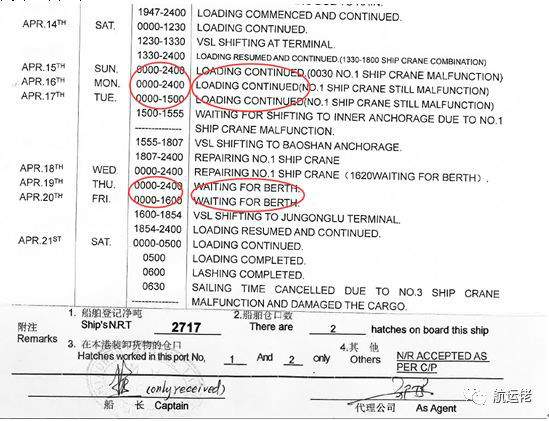
承租人认为船吊损坏的原因是船本身的问题造成的,缺少维修保养,因此主张2018年4月15日0030到2018年4月17日的1500,按比例停租50%;从2018年4月17日1500到2018年4月20日1854全部停租。但按Mocatta法官和Denning勋爵的观点,在2018年4月15日0030到2018年4月17日的1500,承租人必须证明使用岸吊作业的速度比使用船吊作业的速度慢,有时间的时间损失才能停租。但客观事实是,岸吊作业的速度比船吊作业的速度快,因此此段时间承租人无权停租。
从4月17日的1500到1807,以及20日的1600到18454,这两段移泊时间,按Denning勋爵观点,此段时间无需使用船吊作业,承租人安排的任务是移泊,而不是作业,因此船吊损坏与否,都不影响承租人的移泊认为,因此承租人这两段时间得继续支付租金。17日1807到20日的1600,均为在锚地,等泊,承租人需要的服务是在锚地等泊位,因此承租人也无权停租。
涉及本争议,笔者当时友情协助出租人,草拟了如下电邮:
Dear Sirs,
RE: MV “XXX” – C/P dated 23 Mar 2018
1. We refer to the above matter.
2. We act for XXX (“Owners”). We understand that Charterers entered into the captioned time charterparty (“Charterparty”) based on the Fixture Note with dated 23th/March 2018(“Fixture Note”), with you, XXX, as charterers (“Charterers”)in respect of the captioned vessel (“Vessel”).
(References to “Clauses” and “Lines”hereinafter are to those of the Fixture Note and incorporated NYPE93 form.)
3. We have been passed a copy of the recent email exchange between Owners and Charterers, from which we understand that a dispute has arisen between the parties in respect of the off hire at the loading port (i.e.Shanghai, China) and lien cargo at discharging port (i.e. Port Kelang,Malaysia).
4. In particular, we have been passed a copy of the email from Owners to Charterers of 14 May 2018, showing that a balance hire of US$96027.62 is due under the Charterparty from Charterers to Owners as per the invoice attached to that email.
5. As previously mentioned by Owners in correspondence, Owners consider that Charterers’ off hire claim is devoid of merits and must be rejected on the following grounds.
6. Critically, the deduction for alleged off hire purportedly tendered by Charterers at both the loading port and the discharging port were unjustified:
(a) The first deduction for alleged off hire from 15th/April 2018 at 0030hrs to 17th/April 2018 at 1500hrs at the loading port was obviously illegal because:
(i) It was no off hire event; and
(ii) It was no time lost, contrary toLines 220-226 of clause 17. Off Hire.
(b) The second deduction for alleged off hire from 17th/April2018 at 1500hrs to 20th/April 2018 at 1854hrs at the loading portwas obviously illegal on same reason:
(i) It was no off hire event; and
(ii) It was no time lost, contrary toLines 220-226 of clause 17. Off Hire.
(c) The 3rd deduction for alleged off hire from 8th/May2018 at the discharging port was obviously illegal because:
(i) It was no off hire event; and
(ii) Hire falls on due on 4th/May 2018, Owners areentitled to exercise lien for any amount due under this charterparty. See Lines 260-263 of clause 23. Lien.
(d) As the alleged off hire atloading port, It obviously was stevedore damage case.Clause 24 of Fixture Note provide thatShouldany damage be caused to the vessel or her fittings by the stevedores…charterersto remain responsible for damage…, and Line419-432 of Clause 35. Stevedore Damage which provide that the charterers shall pay for any and all damage to the vessel cause by stevedores…the charterers shall immediately arrange for repairs of such damage(s) at their expenses and the vessel is to remain on hire… Charterers failure to arrange for repairs of damage whichput them in breach.
(e) Lines100-105 of Clause 8. Performance of Voyage which provide that …Charterers shall perform all cargo handling,including but not limited to loading, stowing, trimming…at their risk and expense…Under English Law, Charterers must appoint a competent stevedore, see《TimeCharter》Chapter20-LOADING, STOWING, TRIMMING AND DISCHARGING CARGO 20.30;
At the heart of the performance of any time charter will be the loading and discharging of cargoes directed by the charterers to be carried under the charter, see 20.13; Accordingly, where there is damage to thecargo, to other cargo or to the ship…the charterers are liable to the owners for that, see 20.14. Charterers may also refer to [2005] EWCA CiV 17, whereLord Justice Rix cite the Lord Justice Roskill test, held that hatch closing was to be treated as part of the overall cargo operation, and charterers was liable for chief officer injured which was occurred during closing hatch. LJ Rix allow the appeal and find in favour of the owners’ claim, also award those sums to the owners as damage for breach of contract by the charterers.
(f) It’s plainly crane was damaged by stevedore and charterers should be liable for this damage. Charterers also breach their obligation to provide lawful cargo and harmless cargo for the vessel, Clause 4of Fixture Note, …with harmless cargo…;Lines49-69 of Clause 4. Dangerous Cargo/Cargo Exclusions which provide that…excluding any goods of a dangerous,injurious….. The actual weight of that piece of cargo is upto 30.5mts which is dangerous for the vessel, which caused damage to vessel’s crane. See《Time Charter》Chapter9-Lawful Merchandise, 9.9, Wide meaning given to “ dangerous”, Where reads: A particular cargo may be danagerous, despite the fact that cargoes of its typeare not usually so regarded, if its own particular characteristics, including where relevant its owners packaging, enganger the ship or other cargo on board….
(g) As to Charterers or their agent failure to surrender cargo’s information before loading, lack of warning to the master. If the master is made aware of its particular, exceed crane’s SWL, he will require to apply combination cranes to load. SeeMicadav. Texim [1968] 2 Lloyd’s Rep.57,where Justice Donaldson held that the time charterers were in breach to provide dangerous cargo for the vessel.
(h) Even though charterers may place the vessel off hire, which owners denied, charterers must establish in order toput the ship off-hire: see《Time Charter》Chapter25- Off-hire Clause 25.6:
(i) The full working of the ship must been prevented;
(ii) It must have been prevented by one of the causes or eventslisted in the clause;
(iii) There must have been a loss of time from that cause or event.
For above mentioned alleged off hire period, there is no time lost (as showing on SOF, loading continued , waiting for berth ), the full working ofthe vessel was not prevented, could provide the service as charterers’ require.The question is not what the charterers hoped or expected their orders would be, but what service they actually required. See The Berge Sund[1993] 2 Lloyd’s Rept.453, where Lord Justice Staughton said at page 460;and Justice Burto said in his judgment in The TS Singapore [2009] 2 Lloyd’sRep.54.
So if the next operation that the ship needs to undertake is to sail to the discharge port, but she is unable to do so, then the ship is being prevented from working. On the other hand, if the situation is that the ship is unable to sail, but the next operation required of her is to remain at berth and discharge, the full working of the vessel has not been prevented. See《TimeCharter》Chapter 25- Off-hire Clause 25.9.For alleged off hire period a, the vessel was required to remain at berth for loading, for period b, the vessel was required to stay at anchorage to wait forberthing.
(i) As to stevedore, Owners/master ever required stevedore to provide related qualification, but stevedore refuse toprovide. May reasonable presumption that stevedore was not competent.Charterers therefore put them in breach to appoint a competent stevedore, See 《Time Charter》Chapter 20-Loading, Stowing, Trimming and DischargingCargo. 20.30 Charterers must appoint a competent stevedore.
(j) As to the lien at dischargingport,Lines 260-263 of clause 23.Lien which provide that …The Owners shall have a lien upon all cargoes and…for any amounts due under this charter party….Refer to SOA provided by Owners which showing hire falls on due on 4th/May2018, to exercise lien on 7th/May 2018 was justified. As Justice Donaldson sad in The Aegnoussiotis [1977] 1 Lloyd’s Rep.268,the clause 18 contains an undertaking by the charterers to procure for the owners a right of lien over the cargo, it’s charterers’ promise to procure a lien. See《TimeCharter》Chapter30-Liens 30.13.The lien over cargo is exercised at, off or at least reasonably close to the discharge port and the owners exercise it by telling the charterers they are doing so. See 30.19;. In all events,even where the owners have no right to retain possession of the cargo as against its owners, they may still be entitled, as against the charterers, to refuse to perform the charter service of delivering the cargo, relying on Clause 18.See 30.11. Under English law, the right given to owners by Line 110 of the New York Produce form or Line 220 of the Baltime form isa right to retain possession of cargo until monies owed to them by the charterers have been paid. That is, it is a possessory lien. It carries withit, as a corollary, a right to refuse to comply with the charterers’ order forthe delivery of the cargo: in other words, the lawful exercise of the lien excuses the owners from having to perform the charter service of delivering thecargo. See 30.7. The Owners were entitled to refuse to discharge and, if necessary,refuse to enter the first discharg port in order to avoid being forced todischarge. See LondonArbitration 11/02(2002) 591 LMLN 3 case.
7. For the above reasons, Charterers are not entitled to placethe vessel off hire, Charterers made illegaldeductions unilaterally which cause them in breach this charterrparty.
8. Given this issue was stevedore damage, it is not necessary for Owners to rely on their alternative arguments premised upon vessel’s particular were given basis ADA and WOG.
9. For present purposes, however, Owners would reiterate that:
(a) This issue was stevedore damage case which charterers should hold whole responsible and charterers are not entitled to place the vessel off hire at both loading port and discharge port.
(b) Charterers are called upon to remit balance as per Owners’ SOA within this Friday ( 18th/May 2018), Failing which we for and onbehalf of Owners will commence legal procedure in accordance with clause 21 ofFixture Note and Clause 45 of incorporated NYPE 93 form.
10. Owners reserve their rights to supplement and/or revise theirpositions as stated above ifand when necessary.
11. All Owners’ rights are fully and expressly reserved.
但非常遗憾的是,承租人还是选择保持沉默。这种情况下,只能有请专业律师登场了。
曾有国内某协会律师和某组织的总经理,认为涉及船吊的安全负荷问题,WOG不适用。笔者很难理解为何有这种观点,与其身份地位完全不相称。在订约自由的前提下,出租人完全可以将原本SWL30吨的船吊调整为SWL20吨,只要承租人不反对,愿意接受。因为承租人可能在接下来的装卸货过程中,都得使用岸吊作业,不允许使用船吊,那么船吊的安全负荷多少,承租人一点都不在乎。甚至出租人可以直接说船吊不可用,如果承租人也愿意接受的话。类似的情况,主机都有额定的输出功率,但承租人似乎对WOG适用于出租人所作的船舶的航速油耗的规范而没有任何疑义。如果按照他们的逻辑,那么必然WOG不适用于船舶的航速油耗,而这与先例The “Lipa”案相违背。
如果认为WOG不适用船吊,那么必须是在恰定合同前,承租人已经明确提出要用船吊起吊30吨重的货物,要求承租人船吊的安全负荷作出了保证。承租人在这种情况下,假如存在出租人违约,承租人才可能有权利索赔损害赔偿。但是另一方面,如果承租人无法证明出租人在给出船吊这个安全负荷的数据不是真诚善意,没有合理根据,即无法证明出租人在作这些描述的时候存在恶意,那WOG将依然适用。因此,在船舶描述后面加上了WOG,那么必须赋予WOG其含义,对于该措辞的解释问题,可以参之前文章,《Without guarantee的法律效力》一文。
而关于损害赔偿的问题,笔者认为过于遥远,不可追偿。这个话题和本篇没有关系,因此不再作分析。
总结:
时间过得飞快,从起笔到现在已过去一年半,500多个日子,如今,已经整理完毕。去年4月9日发布的公告,已经完成,不多不少,100篇。
海运圈聚焦专栏作者 Alex (微信公众号 航运佬)

 2018-05-29
2018-05-29 2677
2677 







